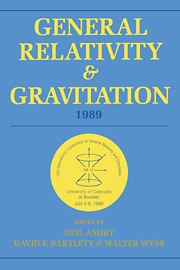 General Relativity and Gravitation, 1989
General Relativity and Gravitation, 1989 Book contents
- Frontmatter
- Contents
- Preface
- Conference committees
- Part A Classical relativity and gravitation theory
- WORKSHOPS
- A1 Exact solutions and exact properties of Einstein equations
- A2 Spinors, twistors, and complex methods
- A3 Alternative gravity theories
- A4 Asymptotia, singularities, and global structure
- A5 Radiative spacetimes and approximation methods
- A6 Algebraic computing
- A7 Numerical relativity
- Part B Relativistic astrophysics, early universe, and classical cosmology
- WORKSHOPS
- Part C Experimental gravitation and gravitational wave detection
- WORKSHOPS
- Part D Quantum gravity, superstrings, quantum cosmology
- WORKSHOPS
- Part E Overviews-past, present, and future
A7 - Numerical relativity
Published online by Cambridge University Press: 05 March 2012
- Frontmatter
- Contents
- Preface
- Conference committees
- Part A Classical relativity and gravitation theory
- WORKSHOPS
- A1 Exact solutions and exact properties of Einstein equations
- A2 Spinors, twistors, and complex methods
- A3 Alternative gravity theories
- A4 Asymptotia, singularities, and global structure
- A5 Radiative spacetimes and approximation methods
- A6 Algebraic computing
- A7 Numerical relativity
- Part B Relativistic astrophysics, early universe, and classical cosmology
- WORKSHOPS
- Part C Experimental gravitation and gravitational wave detection
- WORKSHOPS
- Part D Quantum gravity, superstrings, quantum cosmology
- WORKSHOPS
- Part E Overviews-past, present, and future
Summary
In this report the current status of numerical relativity is presented. Progress in the field is discussed through reviews of work on gravitational radiation and cosmic strings.
Numerical relativity is a young and vital area, growing in many dimensions. This field has its roots in the effort to calculate the gravitational wave emission from astrophysical sources, and it continues to be energized by the promising new developments in gravitational wave detectors. For example, there are a number of new code-building efforts; several of these are aimed at constructing 3-D codes while others are concerned with putting more realistic physics into 1-D and 2-D codes. There is increased activity in combining analytic and numerical techniques to calculate the gravitational radiation produced. And researchers continue to emphasize the need for improved numerical analysis to insure the accuracy and stability of the codes.
There is also increasing diversity in the types of problems being treated numerically, from cosmic strings to inflation, along with the more traditional stellar collapses and black hole collisions. And new people are joining the community, both those just beginning their research careers as well as more experienced researchers crossing over from other areas. The interaction of these new recruits with the “seasoned veterans” of numerical relativity is producing many new ideas and approaches.
This continued blossoming of numerical relativity is fueled by the growth of computing resources.
- Type
- Chapter
- Information
- General Relativity and Gravitation, 1989Proceedings of the 12th International Conference on General Relativity and Gravitation, pp. 121 - 130Publisher: Cambridge University PressPrint publication year: 1990


